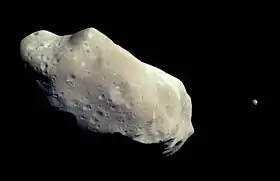Despina (moon)
Despina /dɛˈspaɪnə/, also known as Neptune V, is the third-closest inner moon of Neptune. It is named after Greek mythological character Despoina, a nymph who was a daughter of Poseidon and Demeter.
 Despina as seen by Voyager 2 (smeared horizontally) | |
| Discovery | |
|---|---|
| Discovered by | Stephen P. Synnott[1] and Voyager Imaging Team |
| Discovery date | July 1989 |
| Designations | |
Designation | Neptune V |
| Pronunciation | /dɪˈspaɪnə, dɪˈspiːnə, dɛ-/ |
Named after | Δέσποινα Despœna |
| Adjectives | Despinian |
| Orbital characteristics[2][3] | |
| Epoch 18 August 1989 | |
| 52 525.95 km | |
| Eccentricity | 0.00038 ± 0.00016 |
| 0.33465551 ± 0.00000001 d | |
| Inclination |
|
| Satellite of | Neptune |
| Physical characteristics | |
| Dimensions | 180×148×128 km[4][5] |
Mean radius | 78.0 ± 4.7 km[3] |
| Volume | ~1.8×106 km³ |
| Mass | ~2.2×1018 kg (based on assumed density) |
Mean density | ~1.2 g/cm³ (estimate)[6] |
| ~0.026 m/s2[lower-alpha 1] | |
| ~0.063 km/s[lower-alpha 2] | |
| synchronous | |
| zero | |
| Albedo | 0.09[4][6] |
| Temperature | ~51 K mean (estimate) |
| 22.0[6] | |
Discovery
Despina was discovered in late July 1989 from the images taken by the Voyager 2 probe. It was given the temporary designation S/1989 N 3.[7] The discovery was announced (IAUC 4824) on 2 August 1989, and mentions "10 frames taken over 5 days", implying a discovery date of sometime before July 28. The name was given on 16 September 1991.[8]
Physical characteristics
Despina's diameter is approximately 152 kilometres (94 mi).[9]Despina is irregularly shaped and shows no sign of any geological modification. It is likely that it is a rubble pile re-accreted from fragments of Neptune's original satellites, which were disrupted by perturbations from Triton soon after that moon's capture into a very eccentric initial orbit.[10]
Orbit
Despina's orbit lies close to but outside of the orbit of Thalassa and just inside the Le Verrier ring and acts as its shepherd moon[11] As it is also below Neptune's synchronous orbit radius, it is slowly spiralling inward due to tidal deceleration and may eventually impact Neptune's atmosphere, or break up into a planetary ring upon passing its Roche limit due to tidal stretching.
Notes
- Surface gravity derived from the mass m, the gravitational constant G and the radius r: Gm/r2.
- Escape velocity derived from the mass m, the gravitational constant G and the radius r: √2Gm/r.
References
- Planet Neptune Data http://www.princeton.edu/~willman/planetary_systems/Sol/Neptune/
- Jacobson, R. A.; Owen, W. M., Jr. (2004). "The orbits of the inner Neptunian satellites from Voyager, Earthbased, and Hubble Space Telescope observations". Astronomical Journal. 128 (3): 1412–1417. Bibcode:2004AJ....128.1412J. doi:10.1086/423037.
- Showalter, M. R.; de Pater, I.; Lissauer, J. J.; French, R. S. (2019). "The seventh inner moon of Neptune" (PDF). Nature. 566 (7744): 350–353. Bibcode:2019Natur.566..350S. doi:10.1038/s41586-019-0909-9. PMC 6424524. PMID 30787452.
- Karkoschka, Erich (2003). "Sizes, shapes, and albedos of the inner satellites of Neptune". Icarus. 162 (2): 400–407. Bibcode:2003Icar..162..400K. doi:10.1016/S0019-1035(03)00002-2.
- Williams, Dr. David R. (2008-01-22). "Neptunian Satellite Fact Sheet". NASA (National Space Science Data Center). Retrieved 2008-12-13.
- "Planetary Satellite Physical Parameters". JPL (Solar System Dynamics). 2008-10-24. Retrieved 2008-12-13.
- Marsden, Brian G. (August 2, 1989). "Satellites of Neptune". IAU Circular. 4824. Retrieved 2011-10-26.
- Marsden, Brian G. (September 16, 1991). "Satellites of Saturn and Neptune". IAU Circular. 5347. Retrieved 2011-10-26.
- "Where Are You From? - Credo Reference". search.credoreference.com. Retrieved 2017-02-12.
- Banfield, Don; Murray, Norm (October 1992). "A dynamical history of the inner Neptunian satellites". Icarus. 99 (2): 390–401. Bibcode:1992Icar...99..390B. doi:10.1016/0019-1035(92)90155-Z.
- "Despina | astronomy". Encyclopedia Britannica. Retrieved 2020-11-08.



_flatten_crop.jpg.webp)